
Ever had a customer repeatedly call your business, only to end up frustrated? Odds are, they won’t be calling back again. Probably, they were never connected to the right person and thus never got the resolution. But can your business afford to lose out on such valuable opportunities? The precise answer is No. Fortunately, modern cloud telephony has a solution to this problem through call routing.
Statistics reveal that “83% of customers expect to interact with someone immediately when they contact a company.” Source – Salesforce Research
Additionally, more than half of consumers will switch to a competitor after only one bad experience. Source- Zendesk
Let’s dive into the world of Call Routing- exploring what is call routing, what types of call routing methods are used, why it is used, and which type of call routing is best for your business.
What is Call Routing?
Call routing is a feature of the business phone system that directs incoming business calls to the intended person or department based on a predefined set of rules. In early times, call routing was done manually by human operators using switchboards. However today, this process is entirely automated which is why it is often referred to as Automated Call Routing. There are several factors based on which these routing rules can be defined, such as:
- According to the Time of the Day – Calls arriving after business hours can be directly routed to the night shift team or sent to voicemail.
- The Language Preferred by the Caller – Customers are connected with agents who can communicate effectively in their preferred language.
- Type of Service or Product – Calls are directed to agents with expertise in a specific product/service the caller is interested in.
- The Status of Caller’s Account – Prioritizing calls from high-value clients to provide them with personalized service.
- Location of the Caller – Based on the caller’s geographical location, calls are directed to appropriate regional teams.
- Agent Schedule and Availability – Based on the workload and real-time availability of the agents, calls can be distributed evenly.
- Interactive Voice Response Selection – Calls are directed based on the choice made by the callers using the IVR menus.
- Call History and Customer Data – Based on past interactions, calls can be routed to the same agent they previously interacted with.
Often, it is assumed that call routing is only useful for companies with high call volume so that they can efficiently distribute the calls among the agents. But that’s not the whole truth. Call routing is equally useful for companies, small or big, that want their incoming business calls to reach the right person or team.
Expert Suggestion: Set up Call Routing in a straightforward manner. Outline all typical destinations where you want inbound calls to reach. As you expand, you can incorporate more advanced call routing options.
Is Call Routing Different From Call Forwarding?
This is a common dilemma. Automated Call Routing considers various factors like time, location, agent skills, etc. to direct calls to the agents. On the other hand, Call Forwarding is about redirecting calls from one phone number to another. It is used when a person is unreachable or busy.
Call Routing Example: A Real-World Use Case
Let’s say you recently purchased a high-end smartphone and you’re experiencing technical difficulties with it. Frustrated, you decide to contact the manufacturer’s customer support hotline.
Upon dialing the number, you encounter an automated menu with various options:
- Check Order Status
- Information on Returns and Exchanges
- Inquiries about Products
- Need Technical Assistance
- Know Warranty information
In this case, you opt for “Technical support.”
The IVR system recognizes your registered account details. The system now identifies you as a customer who recently purchased their product. Considering all the gathered information, your call is instantly directed to the technical support team specialized in troubleshooting issues with the specific model of your phone.
This seamless routing of your call along with relevant details to the customer support agent adds efficiency to the overall process. It enables the genet to quickly delve into the technical aspects of your concern, offering personalized assistance to resolve the issue with your smartphone.
This is just one call routing example. There are many real-world scenarios where a business can incorporate different types of call routing strategies to optimize its customer support operations.
How does Call Routing Work?
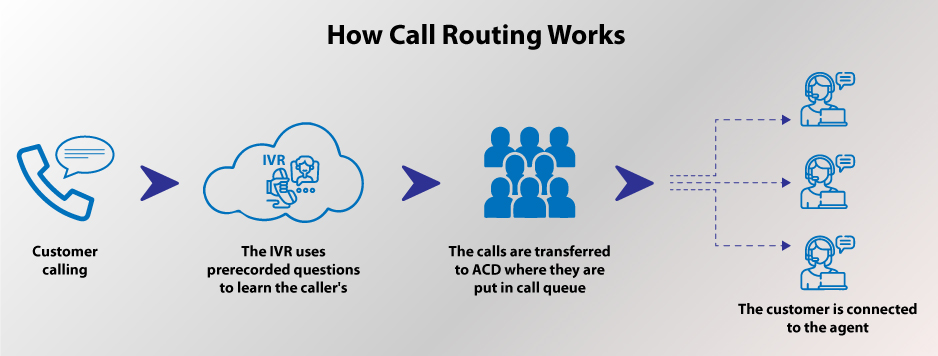
Call Routing is a feature of the business phone system and there are multiple ways through which calls can be routed. A few years back, call routing systems were programmed into phone systems by experts. But now, the modern-day cloud-based phone systems have made it quite simple and easy. Before we dive into that, let’s first understand the 3 main stages of the call routing process:
Call Qualification
The basic aim of this step is to determine the calling intent of the caller. When an incoming call arrives on the business phone system, the caller is presented with a series of prerecorded prompts by the Interactive Voice Response or IVR. Based on the customer’s input via speech or dial pad, the purpose of the call is determined.
Call Queuing
This is the second stage in the call routing process. Here, an ACD i.e. Automatic Call Distributor plays a crucial role. The caller’s response to IVR is forwarded to the ACD which performs these 3 steps:
- It analyzes the input of the caller and identifies their needs
- Determines the best-suited agent or team for the call
- Routes the call to the selected agent of the team
The ACD can line up incoming calls, organizing them according to queries, skills, or waiting time. The priority assigned depends upon the routing rules you define.
Call Distribution
In the last step of the call routing process, the queued calls are routed to individual agents of teams. Similar to the previous step, here also the call is distributed based on the rules defined. In case the call arrives after business hours and no agent is available to take the call, then calls can be directed to voicemail.
As you can see, managing business calls involves a lot of work. But thanks to modern and robust business phone systems like REVE Cloud Telephony they can help you deliver a smooth and seamless call routing experience.
Different Types of Call Routing Methods
“Nearly 90% of customers agree that faster issue resolution (or a higher FCR rate) is the most important aspect of good customer service.” Source
The type of routing you choose for your calls has a direct impact on decreased hold times and increased first-call resolution (FCR) rates. Here are some of the most common types of call routing techniques you can use to distribute incoming calls.
Skills-based Routing
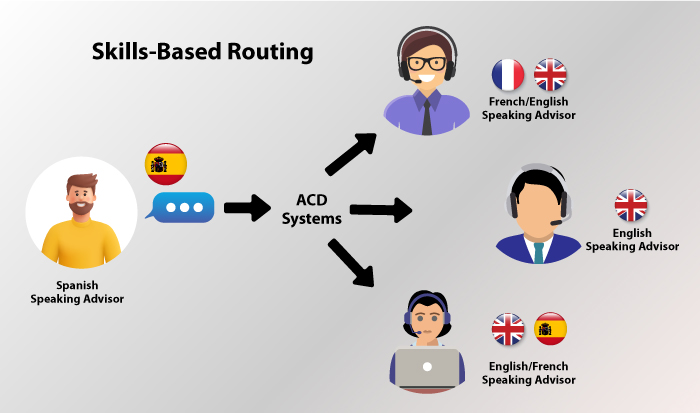
As the term suggests, based on the skills or expertise of the agent, the call is routed. For a better understanding, here’s an example.
Suppose you are a telecom company with a customer support department that handles various queries related to billing, technical issues, etc. Now, your company receives a call from a customer facing a technical problem with their internet connection. The routing system recognizes the nature of the customer query and thus connects the customer with an agent having expertise in technical issues.
Time-based Routing
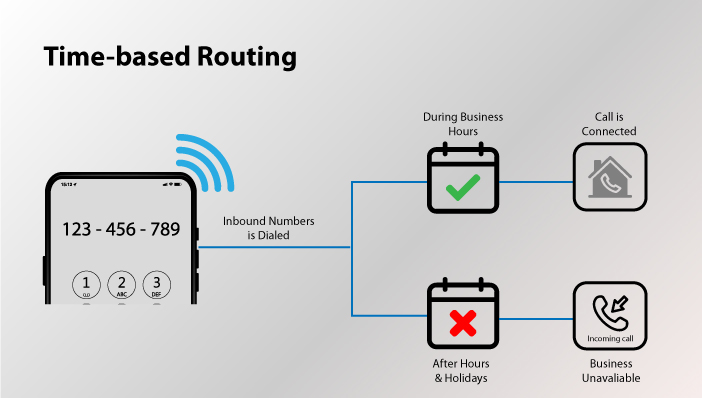
In this type of routing, the business or working hours and time zones of the agents are considered. It is also called schedule-based or time-of-the-day routing. This method is quite popular with contact centers that serve global and geographically diverse customers.
Round-Robin Routing
This method works by equally distributing incoming calls among agents in a sequential manner. For example, there’s a call center setup having multiple agents. Now, multiple customer calls are received simultaneously. The round-robin routing system will assign the first call to Agent A, then the second call to Agent B, then the third call to Agent C, and so on… This method ensures that every agent receives an equal share of incoming calls.
Least Occupied Routing
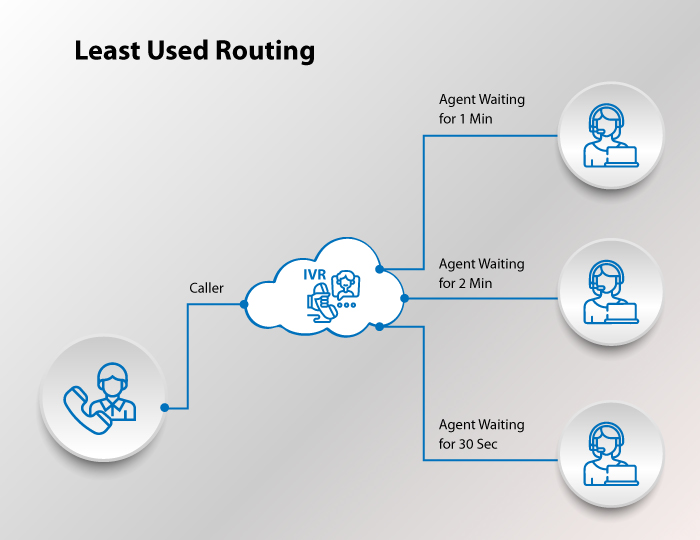
You got this right! This routing system works by routing calls to agents with the least talk time with clients or the fewest calls. Here, the intelligent call routing ACD tracks statistics about these agents to prevent individual team members from getting overburdened with calls.
VIP Routing
This is also called relationship-based routing. This method is used to provide special privileges to high-value clients. For example, you have a list of VIP customers based on their significant value to your business. Now, a VIP customer calls customer support seeking assistance. The VIP Routing system identifies the call and assigns a higher priority to it. Due to this, the customer receives prompt and tailored assistance, enhancing satisfaction among the clientele.
AI-Assisted Routing
It is also termed Predictive Behavioural Routing. This intelligent routing technique makes use of AI i.e. Artificial Intelligence to connect the caller with the best available agent. The prediction is made using machine learning based on live and historical data like prior interactions, communication preferences, account history, etc.
List-based Routing
List-based routing (also called Sequential Routing) works in a fixed order. Calls are always assigned to the first agent on the list, regardless of the activity or skill set of the other agent. Only when the first agent is not available, the call is given to the next available agent. This type of routing is useful in training scenarios or for resource optimization.
IVR Call Routing
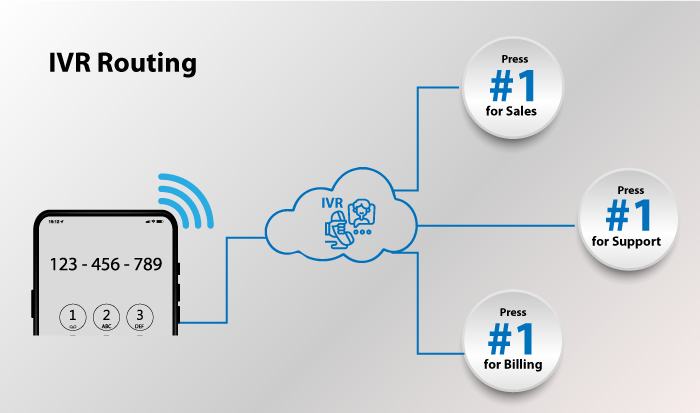
Here the IVR system guides callers through a series of voice prompts or keypad inputs. IVR Call Routing route calls based on the caller’s selections or spoken responses.
Benefits of Call Routing
“55% of consumers are willing to pay more for exceptional customer experiences.”
An intelligent call routing strategy offers immense value to both small and large businesses. However, it is equally beneficial for customers as well. Let’s take a closer look at the advantages of having a call routing system:
Benefits of Call Routing for Call Centers
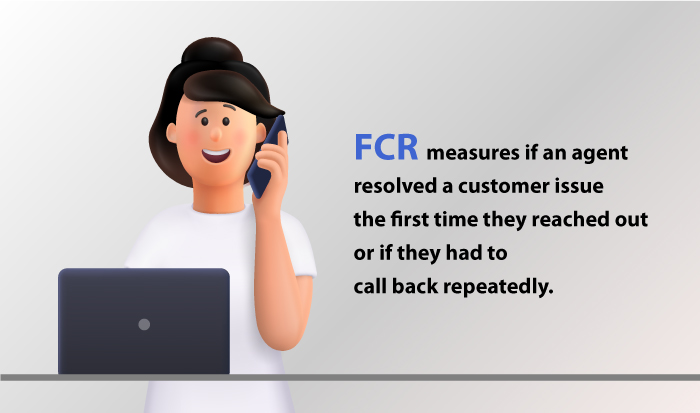
- Improves the FCR Rate, because callers are connected to relevant or qualified agents which increases the likelihood of customers’ concerns getting resolved in the first interaction. For instance, calls related to software issues are directed to agents specialized in software troubleshooting.
- Enhanced Efficiency, due to optimal resource allocation and task distribution. For instance, technical inquiries go to technical support, while billing-related calls are routed to the finance team.
- Lower Operating Costs, due to optimal usage of available agents which reduces the average cost per call.
Benefits of Call Routing for Call Center Agents
- Improved Performance, because agents can handle calls aligned with their skills or expertise.
- More Balanced Workload, because call routing strategies can evenly distribute calls among agents, preventing a single resource from being overloaded.
Benefits of Call Routing for Customers
The data from Microsoft’s State of Global Customer Service report indicates that 33% of customers worldwide feel that getting their issues resolved in a single interaction is their idea of a great customer service experience.
- Connects with the most suitable agent, who can provide resolution in the best possible way, increasing FCR. For example, A customer in New York is automatically directed to the New York store’s customer service line.
- Reduces call wait time by assigning calls to agents as soon as they are available. For example, directing calls to agents in different time zones during their respective working hours.
- Improves customer experience, by offering personalized assistance based on past interactions. For example, calls from VIP customers are routed to a dedicated support team, offering personalized assistance.
Types of Companies that Can Benefit from Call Routing
Will your company benefit if you implement intelligent call routing? The answer to this question is simple.
Any company or business that has multiple employees, departments, or locations can benefit from call routing.
Let’s give you a quick overview:
- Customer Support Centers
- E-commerce Businesses
- Tech Support Firms
- Healthcare Providers
- Financial Institutions
- Travel and Hospitality
- Utility Services
Call Routing Best Practices
By now, you have understood what is call routing and the different types of call routing methods that you can implement. But wait, you need to follow some effective practices to ensure optimal performance and a positive experience for both agents and customers. Let’s take a look:
Keep IVR Prompts ‘To the Point’
Your callers don’t have time to listen to unnecessary details. So make sure you direct them to the IVR submenus rather than long greetings or discount offers. This helps in keeping your IVR routing effective and efficient.
Regularly Review and Update Routing Rules
Businesses encounter changes in customer behavior and business needs now and then. It is important to continuously assess and update routing rules so that your business adapts to these changes.
Let Callers Know their Wait Time and Queue Position
Waiting in a queue can be frustrating, especially if the callers have no idea about the time for which they need to wait. It is always a good idea to provide callers with an estimated wait time and queue position. This makes them feel addressed.
Always offer the Option to Speak with a Live Agent
At times, interacting with an IVR or navigating through IVR call routing becomes uncomfortable for the callers. They should always have the option to be transferred to a live customer support agent so that they don’t end up frustrated.
Frequently Update Call Menus
Your IVR call menus should reflect your operating hours during holidays or special events.
Integrate with CRM Systems
Seamless integration of Call Routing systems with CRM or Customer Relationship Management Tools should be done for better service delivery.
Offer Self-Service Options
For routine inquiries, it is best to let customers find their answers or solutions independently. Therefore, implement self-service options in your IVR system.
How to Set up Flawless Call Routing on a Business Phone System?
Setting up intelligent call routing on a cloud business phone system involves certain steps. Some of the key aspects of implementing call routing solutions are:
Perform Customer Analysis
To build an efficient call-routing system, firstly you should know what your customer concerns are. Aggregate similar queries to create different types of sets. You can even anticipate customer issues to create your routing plan.
Decide Call Flow and Choose the Routing Method
Consider potential scenarios and map out how calls should be routed in different situations based on time, nature of the query, type of caller, etc. With this understanding, you can now select one or more routing methods mentioned above that best aligns with your goals and customer needs.
Set Up Routing Rules
Configure routing rules in your business phone system so that calls are routed as per your chosen methods. Here you can assign priorities, define destinations, and create queues for different types of calls.
The final step is to test, optimize, and start using call routing in your business. You may also like to educate your agents about the new routing system so that they know how the call flow works.
What Type of Call Routing System is Best?
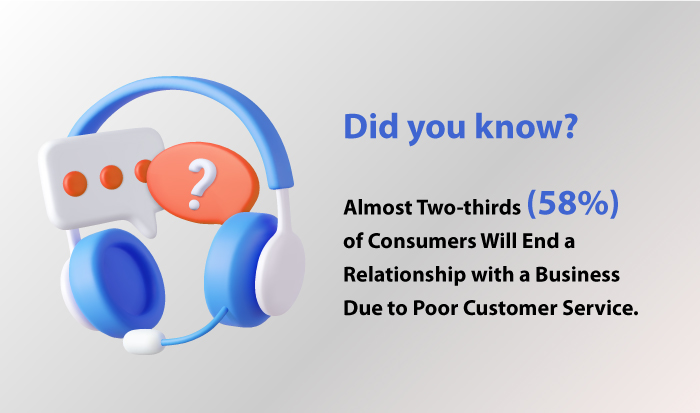
The best call routing system is a combination of different call routing methods that we have mentioned above in this article. You can start by clarifying the main objective of the call through an IVR or automated attendant. Afterward, implement a mix of VIP routing, skills-based routing, and least occupied queue distribution across your call queues.
Now, you may want to know – How much should be the cost of call routing solutions? Modern cloud telephony solutions come with an in-built call routing feature and several other advanced communication tools. Generally, cloud-hosted telephony solutions are cheaper and easier to set up as compared to on-premise solutions.
For small businesses, basic call routing methods like routing based on time will suffice the purpose. For large organizations, multiple and more complex call routing methods may be required to distribute calls efficiently.
Ready to Take the Next Step? Start Routing Calls More Efficiently
Before we wrap up, consider this fascinating insight: According to recent studies, businesses that prioritize personalized call routing experiences witness a significant increase in customer satisfaction scores by up to 30%.
Furthermore, these businesses observe a substantial decline in call abandonment rates, with nearly 40% fewer customers opting to end the call prematurely. This intriguing correlation underscores the profound impact of tailored call routing systems on customer retention and overall satisfaction levels.
As you contemplate these insights, envision the possibilities within your own business or customer service realm. The journey towards exceptional customer experiences begins with strategic call routing.
Cloud telephony solutions like REVE Cloud Telephony make it super easy to set up advanced call routing options to meet any business requirement, with a centralized dashboard. It allows you to manage calls according to different time zones, assign multiple VoIP phone numbers to teams, and terminate calls to multiple teams. Take advantage of a free demo from our experts.




























